Reference Evapotranspiration Variation Analysis and Its Approaches Evaluation of 13 Empirical Models in Sub-Humid and Humid Regions: A Case Study of the Huai River Basin, Eastern China
Abstract
:1. Introduction
2. Materials and Methods
2.1. Study Area and Datasets
2.2. Penman–Monteith FAO-56 Model (PMF-56 Model)
2.3. Empirical Models
2.4. Performance Evaluation Approaches
2.5. Calibration and Validation of the Empirical Models
2.6. Trend Test
3. Results and Discussion
3.1. Monthly Variations of the ETPMF
3.2. Performance Evaluation of the 13 Empirical Models in the HRB
3.3. Calibration of the Empirical Models
3.4. Validation of the Calibrated Empirical Models
4. Conclusions
- (1)
- The ETPMF increased initially and then decreased on a monthly timescale, with the peak value appearing in June and the lowest value appearing in January. The ETPMF exhibited significant decreasing trends in January, June, July, and August; however, in March and April, the ETPMF demonstrated slightly non-significant increasing trends.
- (2)
- On a daily timescale, before the calibration, the VA3 model could be regarded as the best alternative model for estimating reference evapotranspiration in the HRB. However, the PEN, WMO, TRA, and JH models could not be considered appropriate alternative models, because of large errors in their estimations. In particular, the PEN model performed the worst with values of the RRMSE, the MAE, and the NS at 0.580, 1.301, and −0.006, respectively.
- (3)
- During the calibration, the determination coefficients of the temperature-based, radiation-based, and combined models presented change trends that increased primarily and then decreased from January to December. High determination coefficients of these models mainly existed between April and October. On the contrary, the mass transfer-based models revealed opposite change trends from January to December. Despite the fact that the mass transfer-based models showed poor performances in daily scatter plots, the performances of these models in January and December were better, with the determination coefficients of the WMO and TRA models at greater than 0.9 and also greater than that of the VA3 model.
- (4)
- After the calibration, the reference evapotranspiration calculated by each of the 13 empirical models on monthly and annual timescales were very close to that estimated by the PMF-56 model, except for the PEN model, which overestimated the reference evapotranspiration from March to October and also on an annual timescale.
- (5)
- If the comprehensive meteorological datasets were available, the VA3 model would be the best alternative empirical model for the PMF-56 model, because it had an easy computation procedure and generated fewer errors compared to the other 12 empirical models, and it was also highly correlated with the PMF-56 model. After accurate validation for the VA3 model using Equation (5), the calibrated parameters of a and b for each site in the HRB were obtained. Based on data availability, the temperature-based, radiation-based, VA1, and VA2 models are recommended during April–October if corresponding input parameters in Table 2 are accessible in the HRB and other similar regions, whereas the mass transfer-based models are preferable in other months.
Acknowledgments
Author Contributions
Conflicts of Interest
Appendix A
| WMO Number | Stations | Lon. (°E) | Lat. (°N) | H (m) | WMO Number | Stations | Lon. (°E) | Lat. (°N) | H (m) |
|---|---|---|---|---|---|---|---|---|---|
| 54836 | Yiyuan | 118.15 | 36.18 | 301.6 | 58011 | Shanxian | 116.07 | 34.80 | 44.3 |
| 54906 | Heze | 115.43 | 35.25 | 50.8 | 58012 | Fengxian | 116.58 | 34.68 | 40.6 |
| 54908 | Dongming | 115.08 | 35.28 | 59.5 | 58013 | Peixian | 116.92 | 34.72 | 36.7 |
| 54910 | Liangshan | 116.08 | 35.80 | 40.8 | 58015 | Dangshan | 116.33 | 34.42 | 50.9 |
| 54913 | Ningyang | 116.80 | 35.75 | 61.2 | 58016 | Xiaoxian | 116.97 | 34.18 | 39.2 |
| 54914 | Juye | 116.10 | 35.42 | 41.1 | 58017 | Xiayi | 116.13 | 34.25 | 41 |
| 54915 | Jining | 116.58 | 35.43 | 45.2 | 58020 | Weishan | 117.13 | 34.85 | 40.5 |
| 54916 | Yanzhou | 116.85 | 35.57 | 53 | 58024 | Zaozhuang | 117.58 | 34.87 | 74.8 |
| 54917 | Jinxiang | 116.30 | 35.10 | 41.3 | 58026 | Pizhou | 117.85 | 34.30 | 24 |
| 54919 | Zoucheng | 117.00 | 35.42 | 78.9 | 58027 | Xuzhou | 117.15 | 34.28 | 41.9 |
| 54920 | Sishui | 117.27 | 35.65 | 110.4 | 58034 | Tancheng | 118.37 | 34.62 | 38.4 |
| 54923 | Mengyin | 117.92 | 35.72 | 202.9 | 58035 | Xinyi | 118.35 | 34.35 | 29.4 |
| 54925 | Pingyi | 117.62 | 35.50 | 167 | 58036 | Donghai | 118.73 | 34.52 | 35.2 |
| 54927 | Tengzhou | 117.13 | 35.12 | 65.9 | 58038 | Shuyang | 118.75 | 34.10 | 8.8 |
| 54929 | Feixian | 117.95 | 35.25 | 120.5 | 58040 | Ganyu | 119.12 | 34.83 | 9.8 |
| 54932 | Yishui | 118.67 | 35.80 | 160.6 | 58044 | Lianyungang | 119.17 | 34.58 | 4.1 |
| 54936 | Juxian | 118.83 | 35.58 | 108.6 | 58047 | Guanyun | 119.23 | 34.30 | 5 |
| 54938 | Linyi | 118.35 | 35.05 | 86.5 | 58048 | Guannan | 119.35 | 34.10 | 6 |
| 54939 | Junan | 118.83 | 35.25 | 113.1 | 58049 | Binhai | 119.82 | 34.03 | 4.5 |
| 54945 | Rizhao | 119.53 | 35.38 | 22.8 | 58100 | Dancheng | 115.18 | 33.63 | 42.4 |
| 57075 | Ruzhou | 112.83 | 34.18 | 214.2 | 58101 | Luyi | 115.48 | 33.88 | 41.2 |
| 57078 | Ruyang | 112.47 | 34.15 | 307.8 | 58102 | Bozhou | 115.77 | 33.87 | 41.8 |
| 57081 | Xingyang | 113.43 | 34.80 | 140.5 | 58104 | Shenqiu | 115.07 | 33.40 | 42 |
| 57083 | Zhengzhou | 113.65 | 34.72 | 111.3 | 58107 | Linquan | 115.38 | 33.07 | 36.5 |
| 57085 | Xinmi | 113.37 | 34.52 | 289.3 | 58108 | Jieshou | 115.35 | 33.27 | 38.7 |
| 57086 | Xinzheng | 113.73 | 34.40 | 111.9 | 58111 | Yongcheng | 116.38 | 33.93 | 32.7 |
| 57087 | Changge | 113.80 | 34.20 | 88.5 | 58114 | Guoyang | 116.20 | 33.50 | 31.2 |
| 57088 | Yuzhou | 113.50 | 34.15 | 117.2 | 58118 | Mengcheng | 116.53 | 33.28 | 27.5 |
| 57089 | Xuchang | 113.85 | 34.02 | 67.7 | 58122 | Suzhou | 116.98 | 33.63 | 36.7 |
| 57090 | Zhongmu | 114.02 | 34.72 | 82.1 | 58125 | Lingbi | 117.55 | 33.55 | 28.1 |
| 57091 | Kaifeng | 114.38 | 34.77 | 73.7 | 58126 | Sixian | 117.87 | 33.47 | 20.6 |
| 57093 | Lankao | 114.82 | 34.85 | 72.2 | 58129 | Wuhe | 117.88 | 33.13 | 21 |
| 57094 | Weishi | 114.20 | 34.40 | 67.5 | 58130 | Suining | 117.92 | 33.88 | 23.5 |
| 57095 | Yanling | 114.20 | 34.08 | 60.4 | 58131 | Suyu | 118.23 | 33.95 | 28.1 |
| 57096 | Qixian | 114.78 | 34.53 | 60.7 | 58132 | Siyang | 118.72 | 33.70 | 15.6 |
| 57098 | Fugou | 114.40 | 34.08 | 59.3 | 58135 | Sihong | 118.22 | 33.45 | 17 |
| 57099 | Taikang | 114.85 | 34.07 | 53.6 | 58138 | Xuyi | 118.52 | 32.98 | 36.3 |
| 57173 | Lushan | 112.88 | 33.75 | 146.9 | 58139 | Hongze | 118.85 | 33.30 | 19.6 |
| 57179 | Fangcheng | 113.00 | 33.28 | 161.5 | 58140 | Lianshui | 119.27 | 33.78 | 10.2 |
| 57180 | Jiaxian | 113.20 | 33.98 | 118.6 | 58143 | Funing | 119.80 | 33.80 | 3.1 |
| 57181 | Baofeng | 113.05 | 33.88 | 137.5 | 58145 | Chuzhou | 119.17 | 33.53 | 8.3 |
| 57182 | Xiangcheng | 113.50 | 33.85 | 81.4 | 58146 | Jianhu | 119.82 | 33.48 | 3.4 |
| 57183 | Linying | 113.92 | 33.80 | 60.8 | 58147 | Jinhu | 119.03 | 33.03 | 10.9 |
| 57184 | Yexian | 113.65 | 33.60 | 86.7 | 58148 | Baoying | 119.30 | 33.23 | 8.4 |
| 57185 | Wuyang | 113.58 | 33.45 | 92.3 | 58150 | Sheyang | 120.25 | 33.77 | 6.7 |
| 57186 | Luohe | 114.00 | 33.58 | 62.1 | 58158 | Dafeng | 120.48 | 33.20 | 7.3 |
| 57188 | Xiping | 114.00 | 33.38 | 60.6 | 58202 | Funan | 115.58 | 32.63 | 35.7 |
| 57192 | Huaiyang | 114.85 | 33.73 | 46.3 | 58203 | Fuyang | 115.82 | 32.92 | 38.6 |
| 57193 | Xihua | 114.52 | 33.78 | 53.5 | 58207 | Huangchuan | 115.03 | 32.15 | 42.9 |
| 57194 | Shangcai | 114.27 | 33.28 | 60.8 | 58208 | Gushi | 115.67 | 32.17 | 57.9 |
| 57195 | Chuanhuiqu | 114.62 | 33.62 | 47.6 | 58210 | Yingshang | 116.22 | 32.57 | 25.5 |
| 57196 | Xiangcheng | 114.88 | 33.45 | 44.4 | 58214 | Huoqiu | 116.28 | 32.33 | 36.9 |
| 57285 | Tongbai | 113.42 | 32.38 | 149.1 | 58215 | Shouxian | 116.78 | 32.55 | 23.5 |
| 57290 | Zhumadian | 114.02 | 33.00 | 83.3 | 58221 | Bengbu | 117.38 | 32.95 | 26 |
| 57292 | Pingyu | 114.63 | 32.95 | 44 | 58222 | Fengyang | 117.55 | 32.87 | 28 |
| 57293 | Xincai | 114.98 | 32.73 | 39.1 | 58223 | Mingguang | 117.98 | 32.78 | 35.6 |
| 57295 | Zhengyang | 114.35 | 32.62 | 79.7 | 58225 | Dingyuan | 117.67 | 32.53 | 76.7 |
| 57296 | Xixian | 114.73 | 32.35 | 50.1 | 58240 | Tianchang | 119.02 | 32.68 | 21 |
| 57297 | Xinyang | 114.05 | 32.13 | 115.1 | 58243 | Xinghua | 119.83 | 32.93 | 7.3 |
| 57298 | Luoshan | 114.55 | 32.22 | 56.1 | 58244 | Jiangdu | 119.57 | 32.45 | 10.3 |
| 57299 | Guangshan | 114.90 | 32.02 | 50.6 | 58245 | Yangzhou | 119.42 | 32.42 | 9.9 |
| 57390 | Jigongshan | 114.07 | 31.80 | 733.5 | 58251 | Dongtai | 120.32 | 32.87 | 5.1 |
| 57396 | Xinxian | 114.85 | 31.63 | 130.8 | 58254 | Haian | 120.45 | 32.53 | 5.2 |
| 58001 | Suixian | 115.10 | 34.43 | 57.1 | 58264 | Rudong | 121.18 | 32.33 | 3.4 |
| 58002 | Caoxian | 115.55 | 34.82 | 50 | 58301 | Shangcheng | 115.38 | 31.80 | 79.1 |
| 58004 | Minquan | 115.15 | 34.65 | 61 | 58306 | Jinzhai | 115.88 | 31.68 | 94 |
| 58005 | Shangqiu | 115.67 | 34.45 | 51 | 58311 | Luan | 116.50 | 31.75 | 60.4 |
| 58006 | Yucheng | 115.88 | 34.38 | 47.2 |
References
- Chu, R.; Li, M.; Shen, S.; Islam, A.R.M.T.; Cao, W.; Tao, S.; Gao, P. Changes in reference evapotranspiration and its contributing factors in Jiangsu, a major economic and agricultural province of eastern China. Water 2017, 9, 486. [Google Scholar] [CrossRef]
- Tabari, H.; Kisi, O.; Ezani, A.; Talaee, P.H. SVM, ANFIS, regression and climate based models for reference evapotranspiration modeling using limited climatic data in a semi-arid highland environment. J. Hydrol. 2012, 444, 78–89. [Google Scholar] [CrossRef]
- Wen, X.; Si, J.; He, Z.; Wu, J.; Shao, H.; Yu, H. Support-Vector-Machine-Based models for modeling daily reference evapotranspiration with limited climatic Data in extreme arid regions. Water Resour. Manag. 2015, 29, 3195–3209. [Google Scholar] [CrossRef]
- Rahimikhoob, A.; Behbahani, M.R.; Fakheri, J. An Evaluation of Four Reference Evapotranspiration Models in a Subtropical Climate. Water Resour. Manag. 2012, 26, 2867–2881. [Google Scholar] [CrossRef]
- Gocic, M.; Trajkovic, S. Software for estimating reference evapotranspiration using limited weather data. Comput. Electron. Agric. 2010, 71, 158–162. [Google Scholar] [CrossRef]
- Allen, R.G.; Pereira, L.S.; Raes, D.; Smith, M. Crop Evapotranspiration-Guidelines for Computing Crop Water Requirements; FAO Irrigation and Drainage Paper 56; FAO: Rome, Italy, 1998. [Google Scholar]
- Cai, J.; Liu, Y.; Lei, T.; Pereira, L.S. Estimating reference evapotranspiration with the FAO Penman-Monteith equation using daily weather forecast messages. Agric. For. Meteorol. 2007, 145, 22–35. [Google Scholar] [CrossRef]
- Sentelhas, P.C.; Gillespie, T.J.; Santos, E.A. Evaluation of FAO Penman-Monteith and alternative methods for estimating reference evapotranspiration with missing data in Southern Ontario, Canada. Agric. Water Manag. 2010, 97, 635–644. [Google Scholar] [CrossRef]
- Chen, D.; Gao, G.; Xu, C.-Y.; Guo, J.; Ren, G. Comparison of the Thornthwaite method and pan data with the standard Penman-Monteith estimates of reference evapotranspiration in China. Clim. Res. 2005, 28, 123–132. [Google Scholar] [CrossRef]
- Huo, Z.; Feng, S.; Kang, S.; Dai, X. Artificial neural network models for reference evapotranspiration in an arid area of northwest China. J. Arid Environ. 2012, 82, 81–90. [Google Scholar] [CrossRef]
- Liu, Y.; Yu, M.; Ma, X.; Xing, X. Estimating models for reference evapotranspiration with core meteorological parameters via path analysis. Hydrol. Res. 2016, 48, 340–354. [Google Scholar] [CrossRef]
- Feng, Y.; Jia, Y.; Cui, N.; Zhao, L.; Li, C.; Gong, D. Calibration of Hargreaves model for reference evapotranspiration estimation in Sichuan basin of southwest China. Agric. Water Manag. 2017, 181, 1–9. [Google Scholar] [CrossRef]
- Li, M.; Chu, R.; Shen, S.; Islam, A.R.M.T. Quantifying climatic impact on reference evapotranspiration trends in the Huai River Basin of eastern China. Water 2018, 10, 144. [Google Scholar] [CrossRef]
- Mallikarjuna, P.; Jyothy, S.A.; Murthy, D.S.; Reddy, K.C. Performance of recalibrated equations for the estimation of daily reference evapotranspiration. Water Resour. Manag. 2014, 28, 4513–4535. [Google Scholar] [CrossRef]
- Peng, L.; Li, Y.; Feng, H. The best alternative for estimating reference crop evapotranspiration in different sub-regions of mainland China. Sci. Rep. 2017, 7, 5458. [Google Scholar] [CrossRef] [PubMed]
- Cobaner, M.; Citakoğlu, H.; Haktanir, T.; Kisi, O. Modifying Hargreaves-Samani equation with meteorological variables for estimation of reference evapotranspiration in Turkey. Hydrol. Res. 2016, 48, 480–497. [Google Scholar] [CrossRef]
- Citakoglu, H.; Cobaner, M.; Haktanir, T.; Kisi, O. Estimation of monthly mean reference evapotranspiration in Turkey. Water Resour. Manag. 2014, 28, 99–113. [Google Scholar] [CrossRef]
- Feng, Y.; Cui, N.; Zhao, L.; Hu, X.; Gong, D. Comparison of ELM, GANN, WNN and empirical models for estimating reference evapotranspiration in humid region of Southwest China. J. Hydrol. 2016, 536, 376–383. [Google Scholar] [CrossRef]
- Mehdizadeh, S.; Behmanesh, J.; Khalili, K. Using MARS, SVM, GEP and empirical equations for estimation of monthly mean reference evapotranspiration. Comput. Electron. Agric. 2017, 139, 103–114. [Google Scholar] [CrossRef]
- Chauhan, S.; Shrivastava, R.K. Performance evaluation of reference evapotranspiration estimation using climate based methods and artificial neural networks. Water Resour. Manag. 2009, 23, 825–837. [Google Scholar] [CrossRef]
- George, B.A.; Reddy, B.R.S.; Raghuwanshi, N.S.; Wallender, W.W. Decision support system for estimating reference evapotranspiration. J. Irrig. Drain. Eng. 2002, 128, 1–10. [Google Scholar] [CrossRef]
- Trajkovic, S. Comparison of radial basis function networks and empirical equations for converting from pan evaporation to reference evapotranspiration. Hydrol. Process. 2009, 23, 874–880. [Google Scholar] [CrossRef]
- Sabziparvar, A.-A.; Tabari, H. Regional Estimation of Reference Evapotranspiration in Arid and Semiarid Regions. J. Irrig. Drain. Eng. 2010, 136, 724–731. [Google Scholar] [CrossRef]
- Tabari, H.; Grismer, M.E.; Trajkovic, S. Comparative analysis of 31 reference evapotranspiration methods under humid conditions. Irrig. Sci. 2013, 31, 107–117. [Google Scholar] [CrossRef]
- Bourletsikas, A.; Argyrokastritis, I.; Proutsos, N. Comparative evaluation of 24 reference evapotranspiration equations applied on an evergreenbroadleaved forest. Hydrol. Res. 2017. [Google Scholar] [CrossRef]
- UNEP. World Atlas of Desertification, 2nd ed.; United Nations Environment Programme: London, UK, 1997; 182p. [Google Scholar]
- Todorovic, M.; Karic, B.; Pereira, L.S. Reference evapotranspiration estimate with limited weather data across a range of Mediterranean climates. J. Hydrol. 2013, 481, 166–176. [Google Scholar] [CrossRef]
- Shiri, J.; Nazemi, A.H.; Sadraddini, A.A.; Landeras, G.; Kisi, O.; Fard, A.F.; Marti, P. Comparison of heuristic and empirical approaches for estimating reference evapotranspiration from limited inputs in Iran. Comput. Electron. Agric. 2014, 108, 230–241. [Google Scholar] [CrossRef]
- Estévez, J.; Gavilán, P.; Berengena, J. Sensitivity analysis of a Penman-Monteith type equation to estimate reference evapotranspiration in southern Spain. Hydrol. Process. 2009, 23, 3342–3353. [Google Scholar] [CrossRef]
- Dinpashoh, Y.; Jhajharia, D.; Fakheri-Fard, A.; Singh, V.P.; Kahya, E. Trends in reference crop evapotranspiration over Iran. J. Hydrol. 2011, 399, 422–433. [Google Scholar] [CrossRef]
- Jhajharia, D.; Dinpashoh, Y.; Kahya, E.; Singh, V.P.; Fakheri-Fard, A. Trends in reference evapotranspiration in the humid region of northeast India. Hydrol. Process. 2012, 26, 421–435. [Google Scholar] [CrossRef]
- Hargreaves, G.H.; Samani, Z.A. Reference crop evapotranspiration from temperature. Appl. Eng. Agric. 1985, 1, 96–99. [Google Scholar] [CrossRef]
- Penman, H.L. Natural evaporation from open water, bare soil and grass. Proc. R. Soc. A Math. Phys. 1948, 193, 120–145. [Google Scholar] [CrossRef]
- World Meteorological Organization (WMO). Measurement and Estimation of Evaporation and Evapotranspiration; Technical Paper (CIMO-Rep); WMO: Geneva, Switzerland, 1966; Volume 83. [Google Scholar]
- Trabert, W. Neue Beobachtungen uber Verdampfungsgeschwindigkeiten. Meteorol. Z. 1896, 13, 261–263. [Google Scholar]
- Makkink, G.F. Testing the Penman formula by means of lysimeters. J. Inst. Water Eng. 1957, 11, 277–288. [Google Scholar]
- Priestley, C.H.B.; Taylor, R.J. On the assessment of surface heat flux and evaporation using large-scale parameters. Mon. Weather Rev. 1972, 100, 81–92. [Google Scholar] [CrossRef]
- Jensen, M.E.; Haise, H.R. Estimating evapotranspiration from solar radiation. J. Irrig. Drain. Div. 1963, 89, 15–41. [Google Scholar]
- Abtew, W. Evapotranspiration measurements and modeling for three wetland systems in South Florida. J. Am. Water Resour. Assoc. 1996, 32, 465–473. [Google Scholar] [CrossRef]
- Irmak, S.; Irmak, A.; Allen, R.G.; Jones, J.W. Solar and net radiation-based equations to estimate reference evapotranspiration in humid climates. J. Irrig. Drain. Eng. 2003, 129, 336–347. [Google Scholar] [CrossRef]
- Valiantzas, J.D. Simple ET0 forms of Penman’s equation without wind and/or humidity data. I: Theoretical development. J. Irrig. Drain. Eng. 2013, 139, 1–8. [Google Scholar] [CrossRef]
- Valiantzas, J.D. Simple ET0 forms of Penman’s equation without wind and/or humidity data. II: Comparisons with reduced set-FAO and other methodologies. J. Irrig. Drain. Eng. 2013, 139, 9–19. [Google Scholar] [CrossRef]
- Samaras, D.A.; Reif, A.; Theodoropoulos, K. Evaluation of Radiation-Based reference evapotranspiration models under different Mediterranean climates in central Greece. Water Resour. Manag. 2014, 28, 207–225. [Google Scholar] [CrossRef]
- Mann, H.B. Nonparametric test against trend. Econometrica 1945, 13, 245–259. [Google Scholar] [CrossRef]
- Kendall, M.G. Rank Correlation Methods; Griffin: London, UK, 1975. [Google Scholar]
- Sen, P.K. Estimates of the Regression Coefficient Based on Kendall’s Tau. J. Am. Stat. Assoc. 1968, 63, 1379–1389. [Google Scholar] [CrossRef]
- Theil, H. A Rank Invariant Method of Linear and Polynomial Regression Analysis; North-Holland Publishing Co.: Amsterdam, The Netherlands, 1950. [Google Scholar]
- Li, M.; Chu, R.; Shen, S.; Islam, A.R.M.T. Dynamic analysis of pan evaporation variations in the Huai River Basin, a climate transition zone in eastern China. Sci. Total Environ. 2018, 625, 496–509. [Google Scholar] [CrossRef] [PubMed]
- Zhang, K.; Pan, S.; Zhang, W.; Xu, Y.; Cao, L.; Hao, Y.; Wang, Y. Influence of climate change on reference evapotranspiration and aridity index and their temporal-spatial variations in the Yellow River Basin, China, from 1961 to 2012. Quat. Int. 2015, 380, 75–82. [Google Scholar] [CrossRef]
- Zheng, C.; Wang, Q. Spatiotemporal variations of reference evapotranspiration in recent five decades in the arid land of Northwestern China. Hydrol. Process. 2014, 28, 6124–6134. [Google Scholar] [CrossRef]
- Song, X.; Zhu, K.; Lu, F.; Xiao, W. Spatial and temporal variation of reference evapotranspiration under climate change: A case study in the Sanjiang Plain, Northeast China. Hydrol. Res. 2017, 49, 251–265. [Google Scholar] [CrossRef]
- Ahooghalandari, M.; Khiadani, M.; Jahromi, M.E. Developing equations for estimating reference evapotranspiration in Australia. Water Resour. Manag. 2016, 30, 3815–3828. [Google Scholar] [CrossRef]
- Djaman, K.; Irmak, S.; Futakuchi, K. Daily reference evapotranspiration estimation under limited data in eastern Africa. J. Irrig. Drain. Eng. 2016, 143, 1–13. [Google Scholar] [CrossRef]
- Ahooghalandari, M.; Khiadani, M.; Jahromi, M.E. Calibration of Valiantzas’ reference evapotranspiration equations for the Pilbara region, Western Australia. Theor. Appl. Climatol. 2017, 128, 845–856. [Google Scholar] [CrossRef]
- Irmak, S.; Payero, J.O.; Martin, D.L.; Irmak, A.; Howell, T.A. Sensitivity analyses and sensitivity coefficients of standardized daily ASCE-Penman-Monteith equation. J. Irrig. Drain. Eng. 2006, 132, 564–578. [Google Scholar] [CrossRef]
- Jensen, M.E.; Burman, R.D.; Allen, R.G. Evapotranspiration and Irrigation Water Requirements: A Manual; ASCE Manuals and Reports on Engineering Practice, No. 70; ASCE: New York, NY, USA, 1990. [Google Scholar]
- Tegos, A.; Malamos, N.; Koutsoyiannis, D. A parsimonious regional parametric evapotranspiration model based on a simplification of the Penman-Monteith formula. J. Hydrol. 2015, 524, 708–717. [Google Scholar] [CrossRef]
- Tegos, A.; Malamos, N.; Efstratiadis, A.; Tsoukalas, I.; Karanasios, A.; Koutsoyiannis, D. Parametric Modelling of Potential Evapotranspiration: A Global Survey. Water 2017, 9, 795. [Google Scholar] [CrossRef]
- Trajkovic, S.; Kolakovic, S. Wind-adjusted Turc equation for estimating reference evapotranspiration at humid European locations. Hydrol. Res. 2009, 40, 45–52. [Google Scholar]
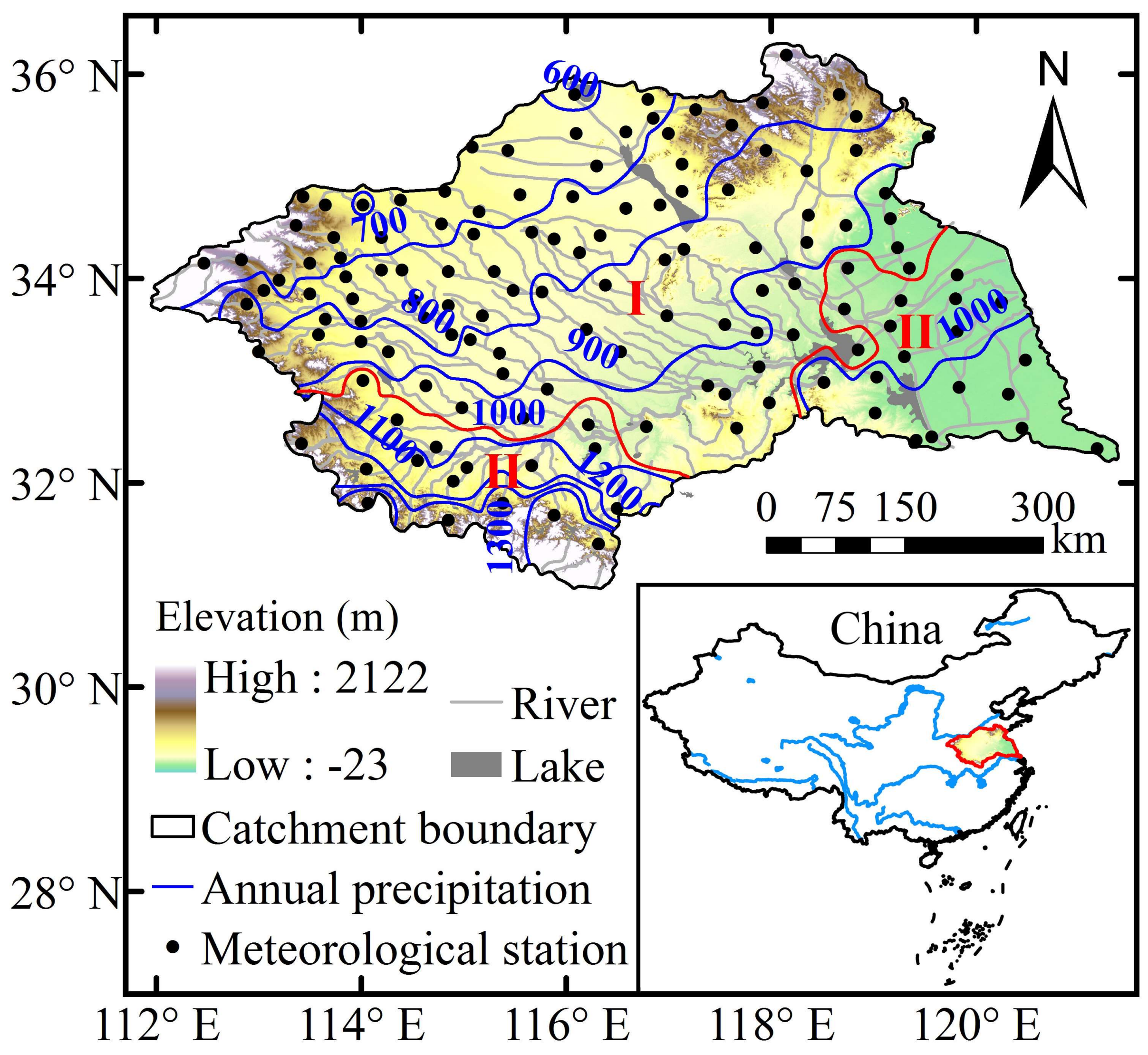
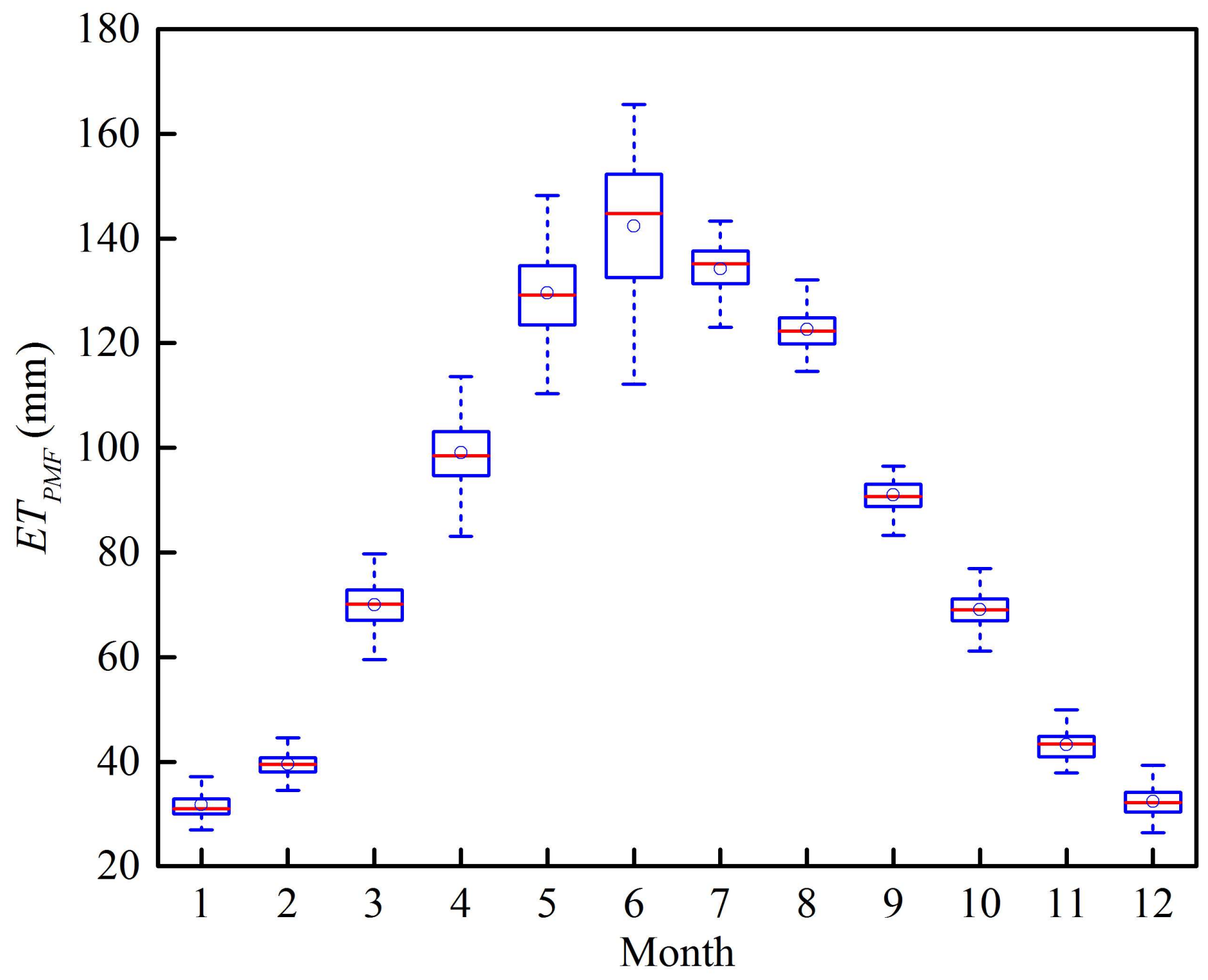
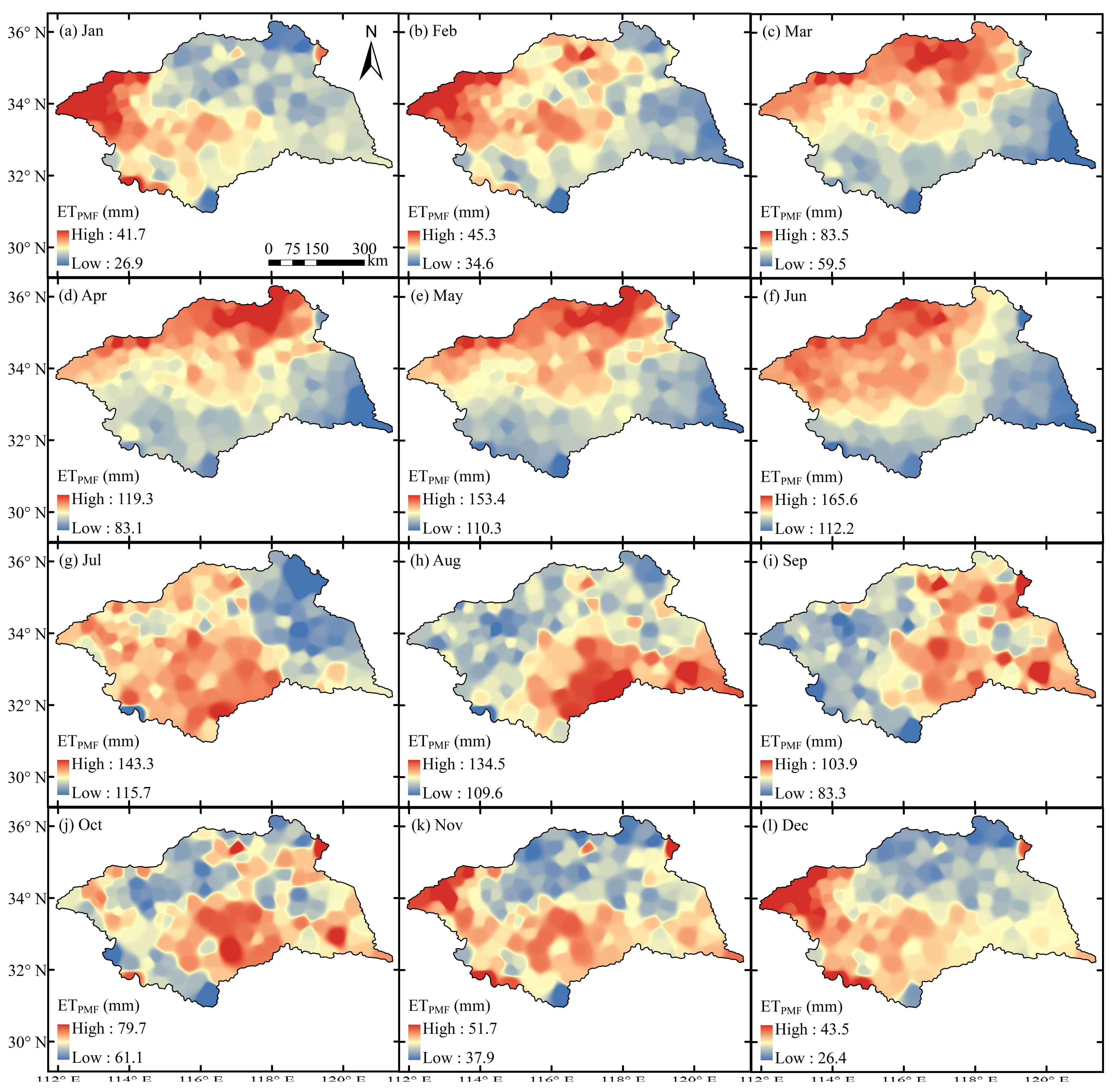

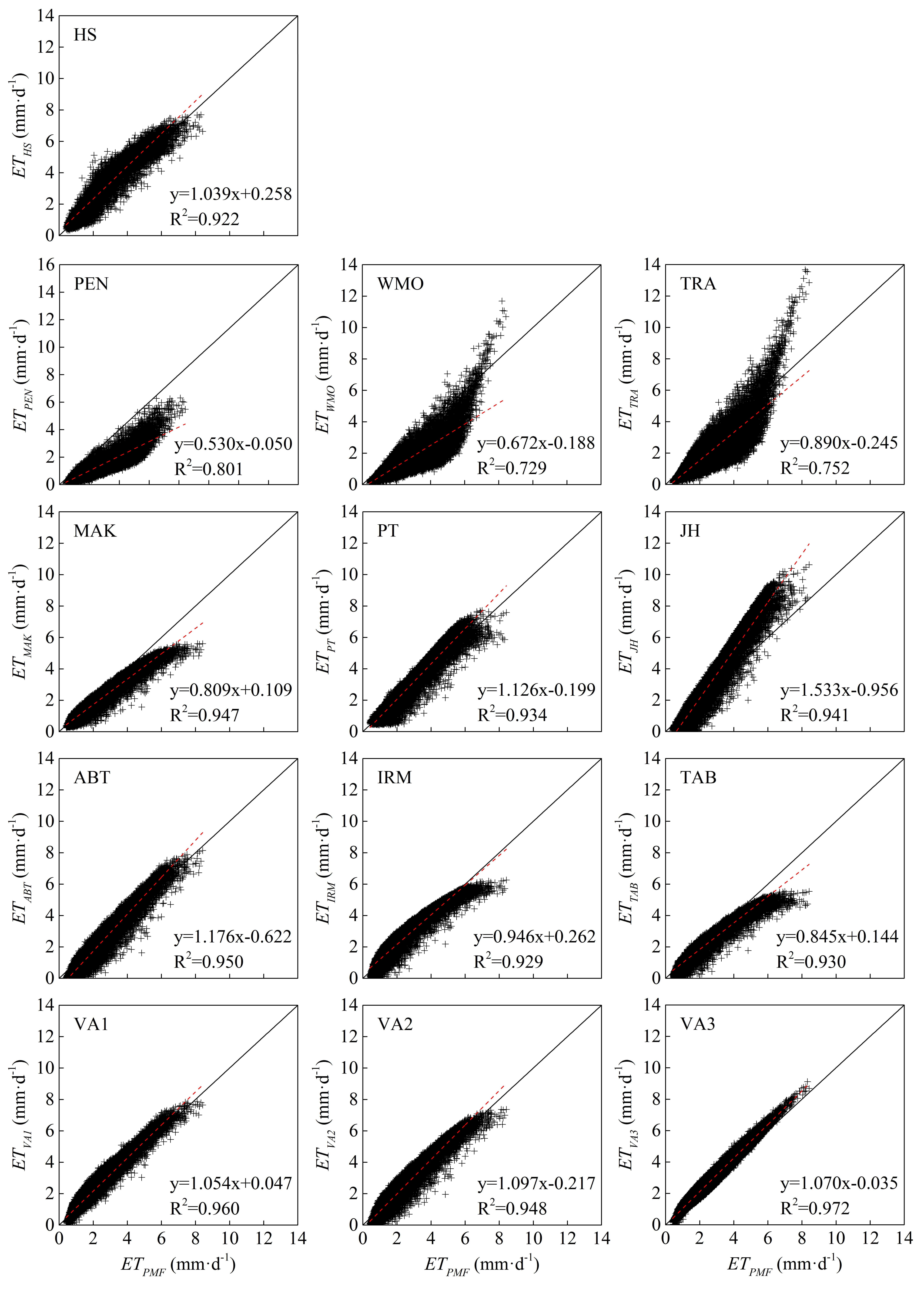

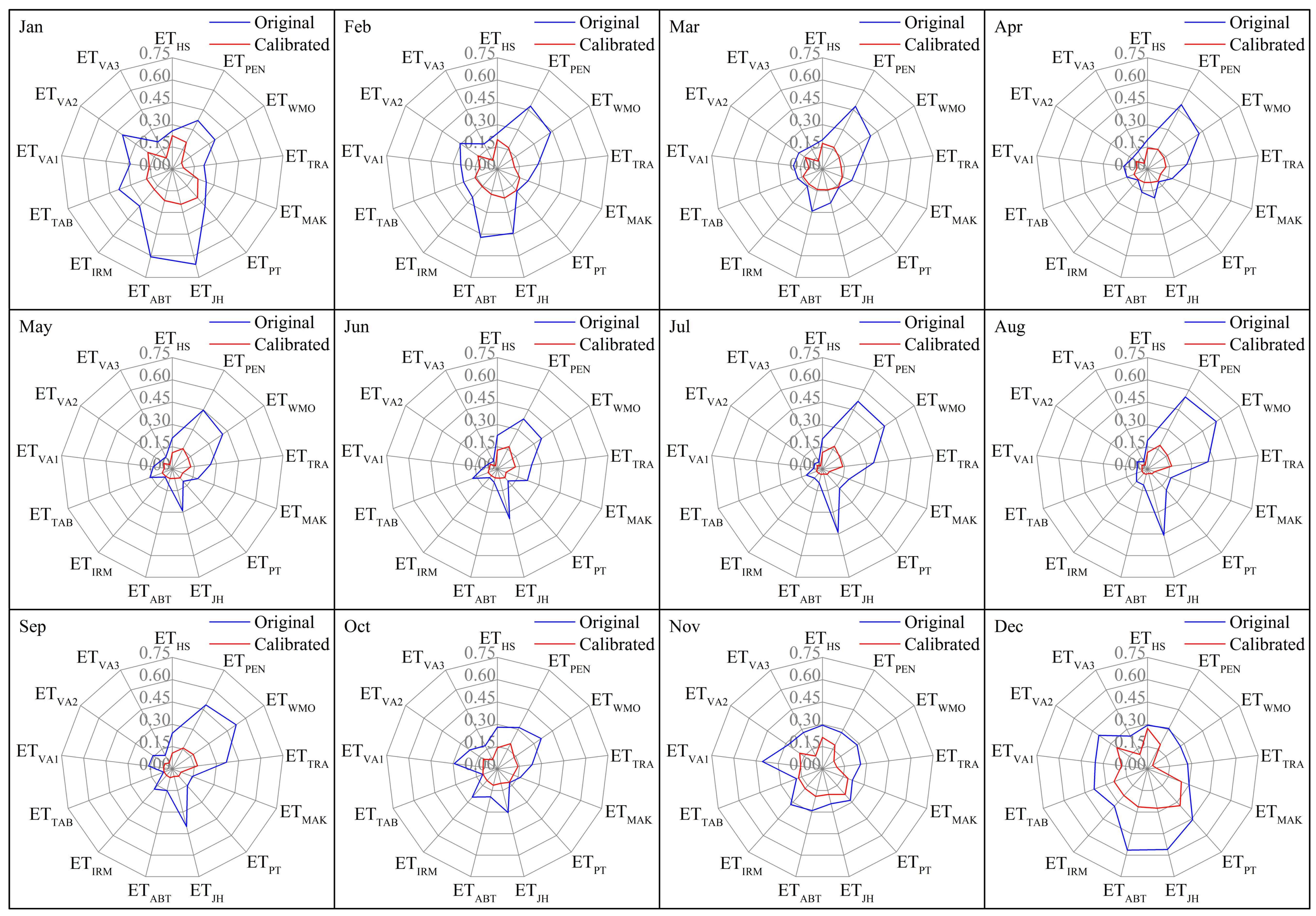
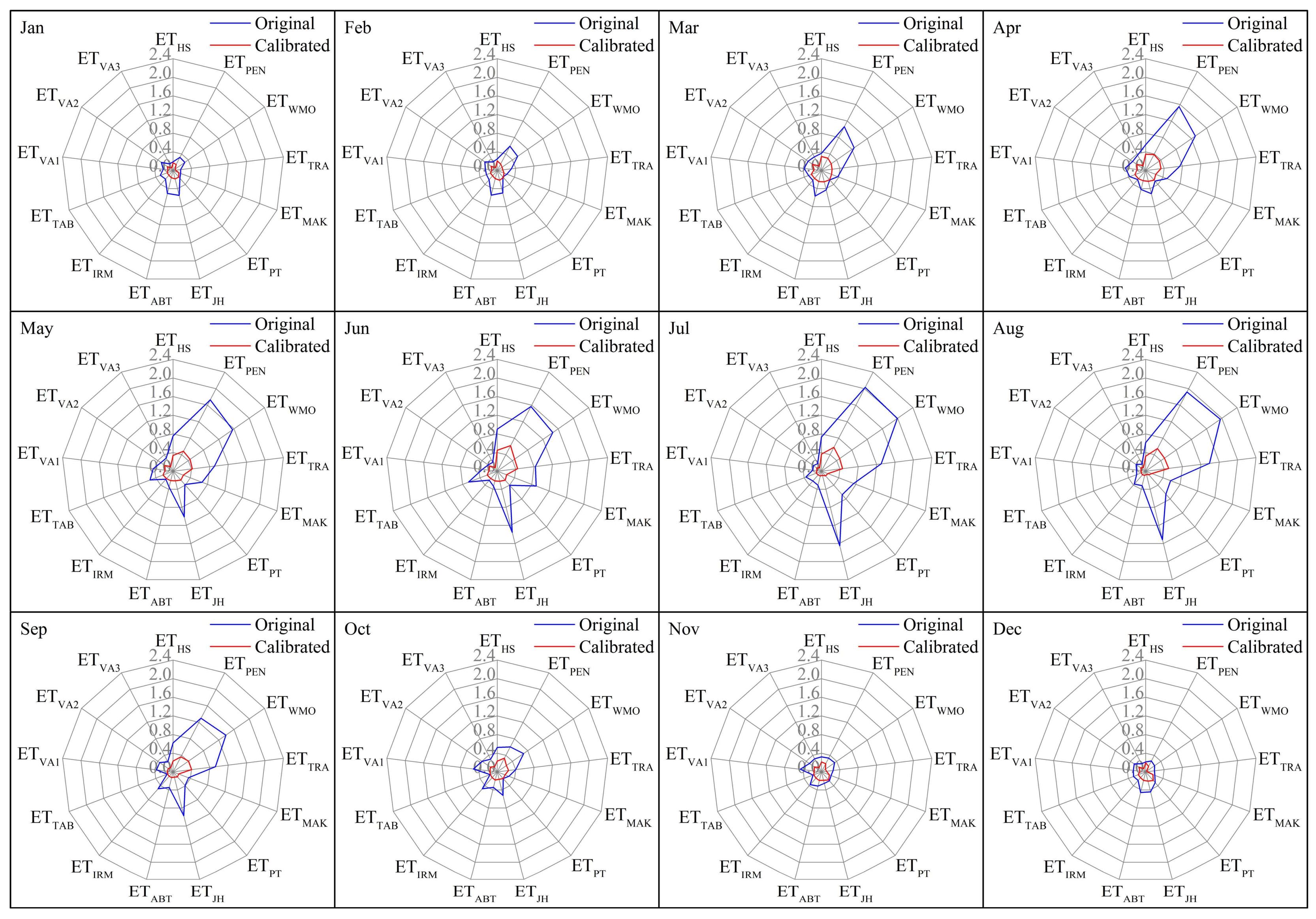
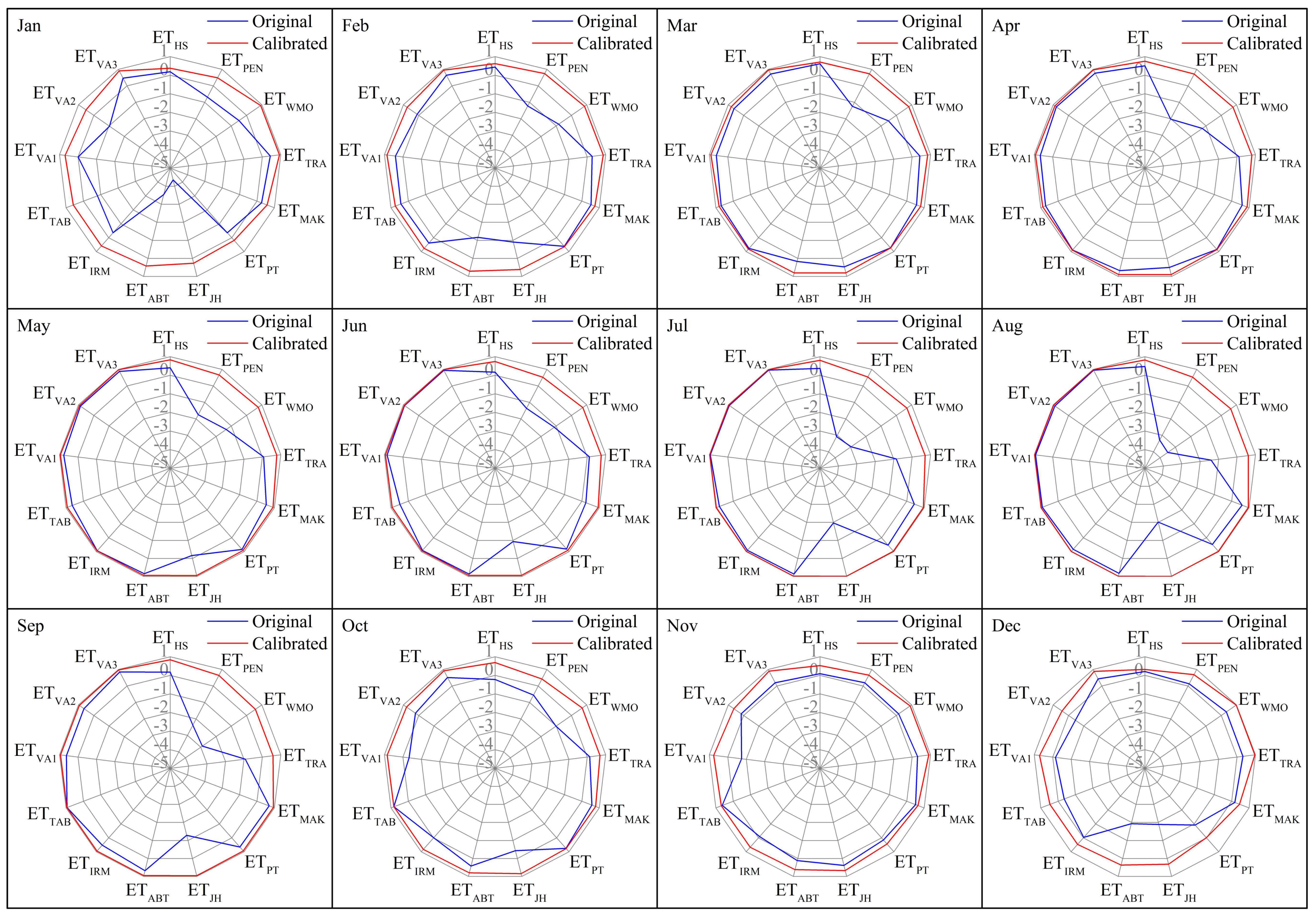

| Region | T (°C) | Tmax (°C) | Tmin (°C) | RH (%) | u2 (m·s−1) | Rs (MJ·m−2·d—1) | Pr (mm·a—1) | ET0 (mm·a—1) |
|---|---|---|---|---|---|---|---|---|
| Sub-humid (I) | 14.45 | 19.93 | 9.84 | 70.29 | 1.86 | 15.08 | 783.05 | 981.23 |
| Humid (II) | 15.03 | 19.88 | 11.12 | 75.96 | 1.95 | 14.85 | 1049.63 | 936.89 |
| Whole | 14.60 | 19.92 | 10.18 | 71.78 | 1.88 | 15.02 | 853.10 | 969.57 |
| NO. | Models | Models Input | Equations | References |
|---|---|---|---|---|
| Temperature-based | ||||
| 1 | Hargreaves–Samani | T, Tmax, Tmin | [32] | |
| Mass transfer-based | ||||
| 2 | Penman | u2, es − ea | [33] | |
| 3 | WMO | u2, es − ea | [34] | |
| 4 | Trabert | u2, es − ea | [35] | |
| Radiation-based | ||||
| 5 | Makkink | Rs, T | [36] | |
| 6 | Priestley–Taylor | Rn, T | [37] | |
| 7 | Jensen–Haise | Rs, T | [38] | |
| 8 | Abtew | Rs, Tmax | [39] | |
| 9 | Irmak | Rs, T | [40] | |
| 10 | Tabari | Rs, Tmax, Tmin | [24] | |
| Combined | ||||
| 11 | Valiantzas1 | Rs, T, RH | [41,42] | |
| 12 | Valiantzas2 | Rs, T, Tmin | [41,42] | |
| 13 | Valiantzas3 | Rs, T, RH, u2 | [41,42] |
| Parameters | Jan | Feby | Mar | Apr | May | Jun | Jul | Aug | Sep | Oct | Nov | Dec |
|---|---|---|---|---|---|---|---|---|---|---|---|---|
| β | −0.108 * | −0.075 | 0.022 | 0.030 | −0.252 | −0.628 *** | −0.330 ** | −0.460 *** | −0.155 | −0.081 | −0.082 | −0.089 |
| Z | −2.074 | −1.015 | 0.149 | 0.269 | −1.701 | −4.148 | −2.716 | −4.252 | −1.925 | −0.985 | −1.343 | −1.641 |
| Parameters | ETHS | ETPEN | ETWMO | ETTRA | ETMAK | ETPT | ETJH | ETABT | ETIRM | ETTAB | ETVA1 | ETVA2 | ETVA3 |
|---|---|---|---|---|---|---|---|---|---|---|---|---|---|
| RRMSE | 0.222 | 0.580 | 0.500 | 0.364 | 0.217 | 0.195 | 0.417 | 0.195 | 0.161 | 0.190 | 0.147 | 0.160 | 0.126 |
| MAE | 0.475 | 1.301 | 1.079 | 0.723 | 0.440 | 0.411 | 0.870 | 0.427 | 0.347 | 0.350 | 0.309 | 0.340 | 0.267 |
| NS | 0.853 | −0.006 | 0.250 | 0.604 | 0.859 | 0.886 | 0.479 | 0.886 | 0.923 | 0.892 | 0.935 | 0.924 | 0.953 |
| Month | Parameters | ETHS | ETPEN | ETWMO | ETTRA | ETMAK | ETPT | ETJH | ETABT | ETIRM | ETTAB | ETVA1 | ETVA2 | ETVA3 |
|---|---|---|---|---|---|---|---|---|---|---|---|---|---|---|
| January | a | 0.671 | 1.188 | 0.783 | 0.639 | 0.709 | 0.868 | 0.477 | 0.562 | 0.467 | 0.562 | 0.606 | 0.506 | 0.613 |
| b | 0.316 | 0.329 | 0.443 | 0.410 | 0.376 | 0.334 | 0.804 | 0.727 | 0.578 | 0.588 | 0.370 | 0.627 | 0.364 | |
| R2 | 0.350 | 0.814 | 0.943 | 0.958 | 0.428 | 0.114 | 0.207 | 0.354 | 0.430 | 0.394 | 0.703 | 0.402 | 0.899 | |
| February | a | 0.825 | 1.311 | 0.851 | 0.685 | 0.908 | 1.244 | 0.712 | 0.721 | 0.648 | 0.772 | 0.680 | 0.665 | 0.664 |
| b | 0.181 | 0.478 | 0.626 | 0.589 | 0.274 | −0.149 | 0.834 | 0.797 | 0.466 | 0.455 | 0.381 | 0.614 | 0.394 | |
| R2 | 0.658 | 0.871 | 0.891 | 0.913 | 0.665 | 0.570 | 0.578 | 0.661 | 0.677 | 0.620 | 0.861 | 0.696 | 0.954 | |
| March | a | 0.902 | 1.443 | 0.826 | 0.687 | 0.995 | 1.098 | 0.763 | 0.785 | 0.830 | 0.983 | 0.761 | 0.748 | 0.721 |
| b | 0.000 | 0.747 | 1.034 | 0.953 | 0.301 | −0.175 | 0.786 | 0.878 | 0.270 | 0.234 | 0.380 | 0.621 | 0.409 | |
| R2 | 0.743 | 0.880 | 0.834 | 0.868 | 0.779 | 0.723 | 0.779 | 0.795 | 0.783 | 0.754 | 0.911 | 0.796 | 0.975 | |
| April | a | 0.946 | 1.338 | 0.763 | 0.636 | 1.014 | 0.964 | 0.663 | 0.756 | 0.987 | 1.144 | 0.792 | 0.770 | 0.770 |
| b | −0.269 | 1.276 | 1.677 | 1.556 | 0.435 | −0.035 | 0.915 | 1.026 | −0.051 | −0.065 | 0.480 | 0.701 | 0.465 | |
| R2 | 0.757 | 0.846 | 0.745 | 0.794 | 0.824 | 0.773 | 0.823 | 0.843 | 0.826 | 0.799 | 0.930 | 0.837 | 0.977 | |
| May | a | 1.072 | 1.113 | 0.710 | 0.567 | 1.129 | 1.045 | 0.694 | 0.798 | 1.213 | 1.398 | 0.828 | 0.855 | 0.806 |
| b | −1.007 | 1.846 | 2.241 | 2.146 | 0.254 | −0.484 | 0.627 | 0.883 | −0.810 | −0.819 | 0.508 | 0.496 | 0.561 | |
| R2 | 0.837 | 0.847 | 0.782 | 0.811 | 0.875 | 0.837 | 0.897 | 0.905 | 0.885 | 0.854 | 0.955 | 0.897 | 0.985 | |
| June | a | 1.278 | 0.985 | 0.622 | 0.496 | 1.212 | 1.080 | 0.710 | 0.850 | 1.403 | 1.557 | 0.864 | 0.931 | 0.827 |
| b | −2.062 | 2.129 | 2.622 | 2.510 | 0.192 | −0.669 | 0.402 | 0.693 | −1.557 | −1.383 | 0.534 | 0.318 | 0.671 | |
| R2 | 0.855 | 0.827 | 0.796 | 0.817 | 0.888 | 0.835 | 0.910 | 0.920 | 0.901 | 0.867 | 0.958 | 0.915 | 0.991 | |
| July | a | 1.417 | 1.265 | 0.750 | 0.607 | 1.151 | 0.920 | 0.628 | 0.807 | 1.330 | 1.431 | 0.885 | 0.902 | 0.864 |
| b | −2.517 | 2.018 | 2.680 | 2.556 | 0.175 | −0.369 | 0.452 | 0.608 | −1.598 | −1.340 | 0.477 | 0.228 | 0.584 | |
| R2 | 0.814 | 0.785 | 0.676 | 0.707 | 0.942 | 0.942 | 0.965 | 0.965 | 0.955 | 0.947 | 0.977 | 0.958 | 0.993 | |
| August | a | 1.365 | 1.377 | 0.925 | 0.713 | 1.069 | 0.864 | 0.596 | 0.759 | 1.225 | 1.322 | 0.836 | 0.842 | 0.850 |
| b | −2.009 | 1.771 | 2.342 | 2.293 | 0.293 | −0.144 | 0.524 | 0.672 | −1.289 | −1.061 | 0.542 | 0.337 | 0.556 | |
| R2 | 0.853 | 0.769 | 0.612 | 0.634 | 0.958 | 0.963 | 0.980 | 0.976 | 0.970 | 0.958 | 0.977 | 0.968 | 0.988 | |
| September | a | 0.997 | 1.086 | 0.774 | 0.605 | 0.892 | 0.830 | 0.564 | 0.663 | 0.969 | 1.090 | 0.700 | 0.697 | 0.746 |
| b | −0.531 | 1.398 | 1.768 | 1.719 | 0.628 | 0.208 | 0.722 | 0.901 | −0.342 | −0.240 | 0.703 | 0.682 | 0.633 | |
| R2 | 0.825 | 0.657 | 0.503 | 0.528 | 0.909 | 0.871 | 0.923 | 0.919 | 0.921 | 0.905 | 0.933 | 0.915 | 0.965 | |
| October | a | 0.797 | 0.984 | 0.736 | 0.572 | 0.806 | 0.888 | 0.573 | 0.613 | 0.796 | 0.952 | 0.623 | 0.612 | 0.667 |
| b | 0.107 | 0.913 | 1.119 | 1.091 | 0.552 | 0.251 | 0.658 | 0.819 | 0.061 | 0.076 | 0.558 | 0.651 | 0.508 | |
| R2 | 0.708 | 0.757 | 0.720 | 0.739 | 0.773 | 0.684 | 0.794 | 0.776 | 0.788 | 0.780 | 0.857 | 0.775 | 0.936 | |
| November | a | 0.625 | 0.960 | 0.712 | 0.563 | 0.692 | 0.802 | 0.510 | 0.531 | 0.551 | 0.683 | 0.567 | 0.498 | 0.623 |
| b | 0.386 | 0.551 | 0.641 | 0.615 | 0.500 | 0.469 | 0.718 | 0.760 | 0.473 | 0.483 | 0.429 | 0.649 | 0.354 | |
| R2 | 0.451 | 0.801 | 0.882 | 0.898 | 0.526 | 0.288 | 0.489 | 0.503 | 0.522 | 0.506 | 0.736 | 0.520 | 0.905 | |
| December | a | 0.589 | 1.078 | 0.740 | 0.595 | 0.667 | 0.477 | 0.466 | 0.499 | 0.453 | 0.579 | 0.575 | 0.449 | 0.606 |
| b | 0.376 | 0.320 | 0.421 | 0.394 | 0.406 | 0.661 | 0.734 | 0.698 | 0.557 | 0.561 | 0.343 | 0.617 | 0.314 | |
| R2 | 0.277 | 0.803 | 0.981 | 0.984 | 0.363 | 0.020 | 0.234 | 0.305 | 0.360 | 0.338 | 0.647 | 0.338 | 0.882 |
© 2018 by the authors. Licensee MDPI, Basel, Switzerland. This article is an open access article distributed under the terms and conditions of the Creative Commons Attribution (CC BY) license (http://creativecommons.org/licenses/by/4.0/).
Share and Cite
Li, M.; Chu, R.; Islam, A.R.M.T.; Shen, S. Reference Evapotranspiration Variation Analysis and Its Approaches Evaluation of 13 Empirical Models in Sub-Humid and Humid Regions: A Case Study of the Huai River Basin, Eastern China. Water 2018, 10, 493. https://doi.org/10.3390/w10040493
Li M, Chu R, Islam ARMT, Shen S. Reference Evapotranspiration Variation Analysis and Its Approaches Evaluation of 13 Empirical Models in Sub-Humid and Humid Regions: A Case Study of the Huai River Basin, Eastern China. Water. 2018; 10(4):493. https://doi.org/10.3390/w10040493
Chicago/Turabian StyleLi, Meng, Ronghao Chu, Abu Reza Md. Towfiqul Islam, and Shuanghe Shen. 2018. "Reference Evapotranspiration Variation Analysis and Its Approaches Evaluation of 13 Empirical Models in Sub-Humid and Humid Regions: A Case Study of the Huai River Basin, Eastern China" Water 10, no. 4: 493. https://doi.org/10.3390/w10040493






